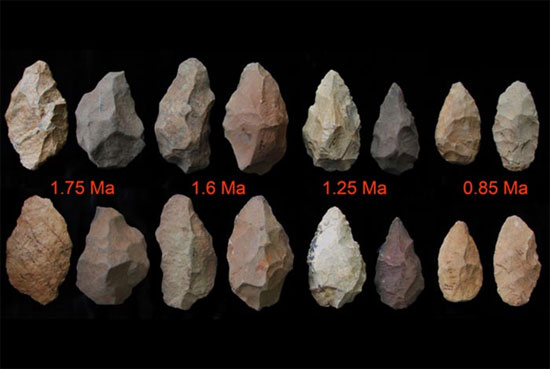Decoding evolution in human hands
The newly discovered fossil has helped explain the transformation at the hands of early humans to become the present form.
According to New Scientist, about 1.7 million years ago, prehistoric people created hand axes, one of the first stone tools of history.
However, until recently, the scientific community has not explained the mechanism behind the evolution of human hands in the direction of fully exploiting the capabilities of early instruments.

Early stone ax tool - (Photo: PNSA)
This is because before the stone ax appeared, our ancestors had extremely weak wrists, unable to hold small objects like hand axes.
Recently, the discovery of a piece of fossil bone has helped experts fill the missing parts in the evolution of human hands, in the period from 1.7 million to 800,000 years ago.
In 2010, a group of experts from the Kenya National Museum found a piece of hand bone.
Later, the University of Missouri (USA) scientists determined that this is the third bone of the human hand, running along the palm of the hand to connect the middle finger to the wrist.
The important bone tissue, thought to be around 1.4 million years old, has the ability to hold the wrist firmly while the person holds a small object between the thumb and the other fingers.
It can be said that this is a very lucky finding because the bones of the first straight people (Homo erectus) are hard to find.
Dr. Mary Marzke of Arizona State University (USA) explained that the bone shows that the hands of human ancestors showed signs of evolution to turn into their current form.
- Human hands evolved to fight
- This is human hands if they are evolved for smartphones
- 6 finger hand is a disaster?
- New discovery of human evolution
- Wukong recognizes the benefits of decoding human genes
- This is evidence that human evolution is still very much 'error'.
- People continue to evolve
- Human evolution
- Human hands evolve earlier than we think
- A new gene shows human evolution
- Human feet and hands have evolved from ancient fish fins
- Wrinkling hands is a sign of evolution?
 Discovered an ancient centipede fossil 99 million years old
Discovered an ancient centipede fossil 99 million years old Discovered bat-like dinosaurs in China
Discovered bat-like dinosaurs in China Discovered a 200-year-old bronze cannon of the coast
Discovered a 200-year-old bronze cannon of the coast Discover 305 million-year-old spider fossils
Discover 305 million-year-old spider fossils